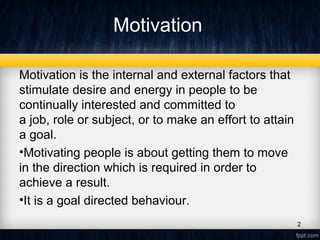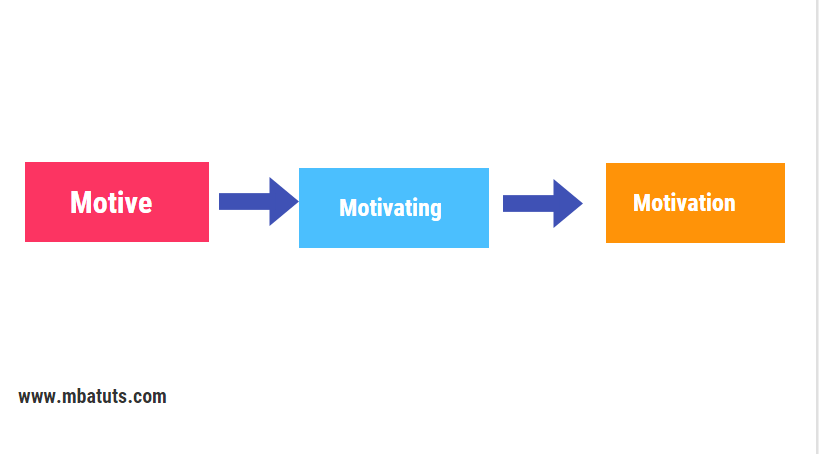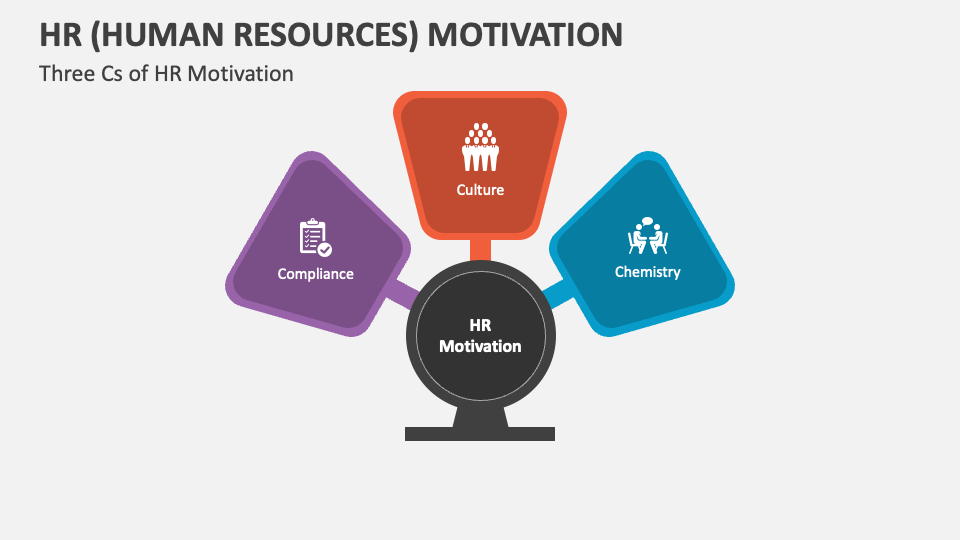Motivation is a key aspect of human resource management, driving employees to perform at their best and achieve organizational goals. By understanding what motivates individuals, HR managers can create strategies that enhance job satisfaction, productivity, and employee engagement.
Effective motivation techniques, such as recognition, rewards, and career development opportunities, can contribute to a positive work environment, lower turnover rates, and increased performance. Motivated employees are more likely to feel valued, committed to their work, and willing to go above and beyond, resulting in a more successful and productive organization.
Ultimately, motivation plays a crucial role in HR management by fostering a positive workplace culture and driving employee performance.

Credit: www.slideshare.net
The Importance Of Motivation In Human Resource Management
Motivation plays a vital role in effective human resource management, driving productivity, job satisfaction, and employee engagement. It fosters a positive work environment where individuals are inspired to achieve their full potential. Effective motivation strategies contribute to the overall success of an organization by maximizing employee performance and retention.
Understanding Motivation
Motivation plays a crucial role in human resource management, as it is the driving force that stimulates employees to perform at their best. Understanding what motivates employees is essential for creating a positive work environment and fostering productivity. When employees are motivated, they are more likely to actively engage in their work, contribute innovative ideas, and strive for excellence.
The Impact Of Motivation On Employee Performance
Employee performance is significantly influenced by their level of motivation. Strong motivation leads to higher job satisfaction, increased productivity, and a willingness to go above and beyond. On the other hand, a lack of motivation can lead to decreased job satisfaction, poor performance, and even employee turnover. Therefore, it is paramount for human resource management teams to prioritize motivation in their strategies to cultivate a motivated workforce that positively impacts overall business performance.
Motivation Techniques For Human Resource Management
Human resource management professionals employ various techniques to motivate their employees effectively. These techniques can be tailored to the needs and preferences of individual employees, ensuring maximum effectiveness. Some common methods used include:
- Recognition and Rewards: Acknowledging employees’ achievements and providing tangible rewards can significantly boost motivation.
- Career Development: Offering opportunities for growth and advancement demonstrates an investment in employees’ future, motivating them to perform better.
- Positive Work Environment: Creating a supportive, inclusive, and transparent workplace fosters motivation and enhances employee engagement.
- Effective Communication: Clear and frequent communication helps employees understand their roles, goals, and the value they bring to the organization, resulting in increased motivation.
- Goal Setting: Setting specific, challenging, and achievable goals motivates employees to strive for success and enhances their sense of accomplishment.
- Flexibility and Work-life Balance: Providing flexibility in work arrangements and promoting work-life balance demonstrates consideration for employees’ personal lives, increasing motivation and satisfaction.
Implementing these motivation techniques empowers human resource management teams to create an environment where employees feel valued, empowered, and motivated to perform their best. Ultimately, motivation is a vital component in optimizing employee performance, fostering engagement, and driving overall organizational success.
Different Types Of Motivation
Motivation in Human Resource Management encompasses various types, including intrinsic and extrinsic motivation, as well as financial and non-financial incentives. These factors play a crucial role in driving employee performance and engagement within organizations.
Intrinsic Motivation
Intrinsic motivation refers to the internal drive and desire that comes from within an individual to pursue a particular goal or task. It is the kind of motivation that stems from personal satisfaction, enjoyment, or the sense of accomplishment that one experiences while engaging in an activity. Intrinsic motivation is often fueled by an individual’s interests, values, and beliefs.
When employees are intrinsically motivated, they are more likely to feel a sense of autonomy, mastery, and purpose in their work. This type of motivation can lead to higher levels of engagement, productivity, and job satisfaction. Intrinsic rewards such as recognition, personal growth, and a sense of fulfillment play a significant role in enhancing intrinsic motivation.
Extrinsic Motivation
On the other hand, extrinsic motivation is driven by external factors such as rewards, incentives, or punishments. It involves engaging in activities or tasks with the aim of attaining some form of external reward or avoiding negative consequences. Extrinsic motivation is often present in a structured work environment where individuals are encouraged to meet certain targets or receive tangible rewards, such as bonuses, promotions, or recognition.
While extrinsic motivation can be effective in encouraging desired behavior and achieving short-term results, its impact on long-term motivation can be limited. External rewards may lose their value over time and fail to provide sustained motivation if they are not aligned with an individual’s internal drivers or values.
Intrinsic Vs. Extrinsic Motivation
The distinction between intrinsic and extrinsic motivation lies in the source of motivation and the underlying reasons for engaging in a particular activity. Intrinsic motivation is driven by internal factors, such as personal interest, enjoyment, and fulfillment, while extrinsic motivation is influenced by external rewards or consequences.
Intrinsic motivation is often associated with long-term commitment, creativity, and self-determination. It fosters a sense of autonomy and encourages individuals to seek challenges and engage in activities out of their own volition. Extrinsic motivation, on the other hand, is more oriented towards the attainment of external rewards or the avoidance of negative consequences.
Understanding the different types of motivation is crucial for effective human resource management. While extrinsic motivation can be useful in certain situations, fostering intrinsic motivation should be a priority for organizations seeking to create a motivated and engaged workforce.
Key Theories Of Motivation
When it comes to managing human resources, motivation plays a crucial role in driving employee productivity and satisfaction. Understanding the key theories of motivation can help organizations create an environment that fosters employee engagement and job performance. In this section, we will explore three prominent theories of motivation: Maslow’s Hierarchy of Needs, Herzberg’s Two-Factor Theory, and McClelland’s Theory of Needs.
Maslow’s Hierarchy Of Needs
Maslow’s Hierarchy of Needs is a popular theory in the field of psychology that explains human motivation in terms of a hierarchical structure of needs. According to this theory, individuals are driven to satisfy their most basic physiological needs such as food, shelter, and safety before moving on to higher-level needs such as social belongingness, esteem, and self-actualization.
In Maslow’s hierarchy, each level of needs must be fulfilled before an individual can progress to the next level. For instance, if an employee’s physiological needs like hunger or thirst are not met, they will not be motivated to pursue higher-level needs such as professional growth or recognition.
Herzberg’s Two-factor Theory
Herzberg’s Two-Factor Theory, also known as the Motivation-Hygiene Theory, proposes that job satisfaction and dissatisfaction are influenced by two distinct sets of factors: motivators (or intrinsic factors) and hygiene factors (or extrinsic factors).
Motivators are related to the nature of the work itself and include factors like achievement, recognition, responsibility, and personal growth. These factors have the potential to inspire employees and create job satisfaction. On the other hand, hygiene factors are external to the work itself and include elements such as salary, work conditions, company policies, and interpersonal relationships. While the presence of hygiene factors does not necessarily motivate employees, their absence or dissatisfaction can lead to job dissatisfaction.
Mcclelland’s Theory Of Needs
McClelland’s Theory of Needs focuses on three primary needs that drive an individual’s behavior: achievement, affiliation, and power. According to this theory, each person has a dominant need that motivates their actions and determines their work-related preferences and behaviors.
The need for achievement is characterized by a desire for personal accomplishment and the attainment of challenging goals. Individuals driven by the need for affiliation prioritize interpersonal relationships, teamwork, and social acceptance. Finally, individuals with a high need for power seek to influence others, take charge, and make a significant impact on their work environment.
Understanding employees’ dominant needs can help managers tailor their motivational strategies to align with individual preferences and create a more engaging and productive work environment.

Credit: www.mbatuts.com
Creating A Motivating Work Environment
One of the key responsibilities of human resource management is to create a motivating work environment that helps employees perform at their best. Motivation plays a vital role in driving employee productivity, engagement, and satisfaction. When employees are motivated, they feel a sense of purpose and are more likely to give their best to their work. In this article, we will explore three crucial factors that contribute to creating a motivating work environment: providing meaningful work, recognition and rewards, and career development opportunities.
Providing Meaningful Work
Meaningful work is the foundation of a motivated workforce. When employees understand how their work contributes to the overall goals and objectives of the organization, they feel a sense of purpose and fulfillment. As a human resource manager, it is essential to ensure that the work assigned to each employee aligns with their skills, strengths, and interests. Here are some strategies to provide meaningful work:
- Design job roles that offer a variety of tasks and challenges, allowing employees to utilize their skills and abilities fully.
- Clearly communicate the importance of each employee’s role and how it contributes to the organization’s success.
- Create opportunities for employees to provide input and make decisions that have an impact on their work.
- Encourage collaboration and teamwork to foster a sense of belonging and purpose.
Recognition And Rewards
Recognition and rewards play a crucial role in motivating employees and reinforcing desired behaviors. When employees feel appreciated and valued for their contributions, they are more likely to remain engaged and motivated. Here are some ways to provide recognition and rewards:
- Create a culture of appreciation by acknowledging and celebrating employee achievements and milestones.
- Implement a reward system that recognizes exceptional performance and goes beyond monetary incentives.
- Provide regular feedback and praise for a job well done.
- Offer opportunities for career growth and development that are tied to performance and achievements.
Career Development Opportunities
Providing employees with career development opportunities is essential for fostering motivation and growth. When employees see a clear path for advancement and development within the organization, they are more likely to be motivated to perform well. Here are some strategies to offer career development opportunities:
- Provide training and development programs that enhance employees’ skills and knowledge.
- Mentorship programs that pair employees with experienced professionals within the organization.
- Offer opportunities for job rotation and cross-functional assignments to broaden employees’ experiences.
- Establish a clear performance management system that includes regular performance evaluations and development plans.
Creating a motivating work environment requires a holistic approach that encompasses meaningful work, recognition and rewards, and career development opportunities. By implementing these strategies, human resource managers can create an environment where employees feel motivated, engaged, and empowered to excel in their roles.
Effective Communication For Motivation
Effective communication plays a crucial role in motivating employees within an organization. When it comes to human resource management, the ability to communicate effectively can be the key to inspiring and empowering team members. In this article, we will explore the fundamental role of communication in motivation and delve into specific aspects such as building trust and transparency, as well as feedback and performance management. Let’s dive in!
The Role Of Communication In Motivation
Communication serves as a vital aspect of motivation within an organization. It acts as the foundation for establishing clear expectations, sharing goals, and fostering collaboration among team members. Clear and concise communication helps employees understand their roles and responsibilities, ensuring everyone is aligned with the organizational vision. Effective communication can also strengthen the bond between managers and their subordinates, leading to improved morale and job satisfaction.
Building Trust And Transparency
Trust and transparency are essential elements for boosting motivation among employees. By fostering an environment of open communication, organizations can establish trust with their employees. Managers who communicate openly and honestly build credibility and create a sense of psychological safety within the workplace. When employees feel trusted and valued, they are more likely to feel motivated and engaged in their work. Transparent communication also enables employees to understand how their individual contributions align with the overall objectives of the organization, further enhancing motivation.
Feedback And Performance Management
Feedback plays a pivotal role in shaping employee motivation and performance. Effective communication enables managers to provide timely and constructive feedback, highlighting areas of improvement and recognizing achievements. By offering specific and actionable feedback, managers can guide employees in enhancing their skills and capabilities. This fosters a continuous learning culture within the organization, where employees feel motivated to grow and develop. Additionally, communication facilitates performance management conversations, enabling managers to set clear goals, track progress, and provide support, all of which are vital for sustaining motivation.
In summary, effective communication is a crucial tool for motivating employees within the realm of human resource management. It ensures that expectations are clear, trust is established, and feedback is provided effectively. By incorporating these communication strategies, organizations can foster a highly motivated workforce that thrives on collaboration, engagement, and continuous improvement.
Challenges In Motivating Employees
Motivating employees is a key aspect of human resource management, but it comes with its fair share of challenges. Understanding and addressing these challenges is crucial for creating an engaged and productive workforce. In this section, we will explore three major challenges that organizations often face when it comes to motivating their employees: individual differences and motivation, overcoming resistance to change, and managing motivation in a diverse workforce.
Individual Differences And Motivation
Every employee is unique, and their motivations can differ based on factors such as personality, values, and life experiences. Recognizing these individual differences is essential for effective employee motivation. Here are some strategies to consider:
- Provide opportunities for meaningful work: Employees are more likely to be motivated when they find purpose and significance in their tasks. Assigning meaningful projects or involving employees in decision-making processes can boost their motivation levels.
- Offer flexible incentives: Tailor incentives and rewards to meet individual preferences. While some employees may value financial incentives, others may be more motivated by recognition or career growth opportunities. Assessing these preferences and providing a range of rewards can increase motivation across the workforce.
- Foster a supportive work environment: Creating a positive and inclusive work environment where employees feel valued and supported can have a significant impact on motivation. Encouraging teamwork, collaboration, and open communication can help address individual differences and ensure everyone feels motivated and engaged.
Overcoming Resistance To Change
Change is inevitable in organizations, but it is often met with resistance from employees. Motivating employees to embrace change can be a daunting task, but by implementing the following strategies, organizations can overcome this challenge:
- Communicate openly and effectively: Keeping employees informed about the reasons behind the change, its benefits, and potential outcomes can help alleviate resistance. Transparent communication helps employees understand the necessity of change and motivates them to support it.
- Involve employees in decision-making: Giving employees a voice in the change process can foster a sense of ownership and increase their motivation to adapt. By soliciting their input, organizations can tap into their expertise and make them feel valued as partners in the change initiative.
- Provide support and resources: Change often requires employees to learn new skills or adjust to new ways of working. Offering training programs, mentorship, and sufficient resources can help employees feel equipped and motivated to navigate the change successfully.
Managing Motivation In A Diverse Workforce
In today’s globalized workforce, organizations are becoming more diverse. Managing motivation in such a workforce presents unique challenges, but by taking the following steps, organizations can foster motivation and inclusivity:
| Step | Description |
|---|---|
| 1 | Promote diversity and inclusion: Actively promote diversity and inclusion within the organization. Recognize and celebrate differences among employees, creating an environment where everyone feels valued and motivated. |
| 2 | Ensure fair and equal opportunities: Establish policies and practices that ensure fair treatment and equal opportunities for all employees. Inequities in promotions or rewards can demotivate individuals and erode trust in the organization. |
| 3 | Adapt motivational strategies: Tailor motivational strategies to accommodate diverse needs. Recognize that different cultural backgrounds, values, and communication styles may require personalized approaches to motivation. |
By embracing diversity and customizing motivational approaches, organizations can effectively manage motivation in a diverse workforce, creating an inclusive and engaged environment.

Credit: www.collidu.com
Frequently Asked Questions On Motivation Is Human Resource Management
What Is Motivation Theory In Hr?
Motivation theory in HR explains what drives employees to perform at their best. It focuses on understanding and meeting their needs and creating a positive work environment. This theory helps HR professionals identify strategies to inspire and engage employees, leading to higher productivity and satisfaction.
What Is Motivation In Management?
Motivation in management is the process of inspiring and encouraging individuals to perform their best in achieving organizational goals. It involves using incentives, rewards, and recognition to boost employee morale and productivity. Effective motivation improves employee satisfaction and drives success in the workplace.
What Motivates You To Be An Hr?
I am motivated to be an HR because I enjoy helping people, resolving conflicts, and fostering positive work environments.
What Is Motivation In Human Relations?
Motivation in human relations refers to the drive that influences how individuals interact with others. It helps foster mutual understanding and teamwork by encouraging positive behaviors and performance.
Conclusion
Motivation plays a pivotal role in effective human resource management. By understanding the underlying factors that drive individuals, organizations can create an environment that fosters productivity and employee satisfaction. From recognizing achievements to providing opportunities for growth, the power of motivation cannot be underestimated.
By incorporating strategies to boost motivation, businesses can unlock their full potential and achieve long-term success. Embracing motivation as an integral part of human resource management can lead to a more engaged workforce, higher productivity, and a positive work culture.